In summary, there are two important reasons why I believe it’s more important to direct additional resources towards animal welfare over global health:
- Global health and human welfare are generally improving whilst animal suffering is getting worse at a worrying (and potentially accelerating) rate. For factory farming, the default is it gets worse and worse over the next 50 years. In my view, it’s still unclear if we’ll end factory farming and we’re competing with a very powerful incumbent industry to make it happen. I don’t believe the same trajectory is true for global health.
- Animal welfare is orders of magnitude more neglected on most important metrics: Philanthropic funding, government funding or great people working on the issue.
These reasons aren’t necessarily all that is required to think it would be better to spend an additional $100M on animal welfare relative to global health (see the 80,000 Hours profile on factory farming for a more comprehensive overview) but they’re notable for me. They’re also part of the main reason I stopped working on things to improve human welfare (via tackling climate change) to focus my efforts on animal welfare.
Global health is progressing whilst animal suffering rapidly increases
Our World in Data has some great information about changes in important metrics and numbers over time. If you scour the website, you’ll see that for most (not all) human welfare-related metrics, things are improving. Whether it’s the share of people in poverty, child mortality, life expectancy, income or some of the other metrics listed below, things are generally going in a positive direction.
This should be cause for celebration – the human condition is improving. We’re managing to live longer and healthier lives, be richer, and generally reduce the death rate of infectious diseases (except when struck by a pandemic).
However, the charts look very different when thinking about animal welfare. On almost every major metric, things are getting rapidly worse. For example, there is a worrying rise in the number of land animals killed for meat per year.
The FAO also predicts that meat consumption will grow by 40% by 2050 relative to 2020 levels, showing that increased suffering for farmed animals is our default trajectory.
Sadly, this trend isn’t limited to terrestrial animals. Aquatic animals, farmed in the hundreds of billions, follow the same trend. The below graph shows the number of farmed fish globally and the numbers for farmed shrimp are even higher, estimated to be around 440 billion (!) per year. These numbers are hard to comprehend, but it’s important to try.
Of course, there may be doubts about sentience for these animals. I won’t make that case here as much smarter people than me have done so – see the Rethink Priorities work here on Welfare Ranges or Jonathan Birch et al. on decapod crustaceans (which influenced UK legislation on this issue).
What is important is that the most important number for farmed animal welfare, the number of farmed animals suffering, is increasing year-on-year, with no signs of plateauing.
Sadly, it gets worse. At least in the case of climate change, where emissions are still (relatively very slowly) increasing, there is a rapid growth in climate change-mitigating technologies. Renewable energy (one of the key solutions to climate change) is experiencing enormous growth, indicating that displacement and a reduction in greenhouse gases are fairly imminent.
Consumption of plant-based meats and alternative proteins (the renewables of the farmed animal movement) are in a much worse place. You would think the private sector might have this covered but that is far from the case:
- Sales for the plant-based sector have flat-lined, with no clear mass-market adoption of plant-based meats.
- Cultivated meat has already been banned in Italy, Alabama and Florida, with additional interest in doing so from Hungary, Austria, other US states and maybe even the entire EU.
- Investment in the sector has also dried up – GFI estimates that alternative protein investment in 2023 was about 28% of what it was in 2021. As a result, many companies have been or will be forced to close or merge.
It isn’t all bad (see Lewis Bollard’s newsletter on some of his hopes for the industry) but it does signal that left purely to market forces, alternative proteins will likely not displace significant (e.g. 20%+) amounts of meat consumption anytime soon.

Note: The chart above shows things cumulatively, likely to avoid the bad look of having rapidly shrinking investment in the most recent two years. But make no mistake, $5.6B to $1.6B is a huge drop in investment for alternative proteins.
Additionally, the percentage of vegans/vegetarians, even in our most successful advocacy countries, also shows a worrying picture. There has been basically no more than a 1.5 percentage point increase in the population of veganism and vegetarianism over the past 20 years.
(I’ll be honest, I barely know what is happening in that last graph but focus on the red dotted line which is the author’s best guess where he aggregates several different polls).
That’s probably enough graphs – I think you get the point. Long story short: Whilst there are some glimmers of progress around the world, we’re losing the war.
In my opinion, this makes it all the more important to work on farmed animal advocacy. The current trajectory of society is a huge increase in animal suffering over the next few decades, as the human population continues to increase, many countries become richer and eat more meat and factory farming spreads to less developed countries. As such, the opportunity for counterfactual impact is huge – we have an opportunity to act now to avert untold suffering.
In contrast, I expect that we will, without additional funds, significantly improve global health outcomes over the next 80 years, as has been the trend shown by the graphs above. There is almost no coordinated opposition to this issue, there is mainstream public and governmental support and many resources dedicated to it (see below).
(Someone here might say that tackling farmed animal welfare must be intractable then – why should we bother? I don’t think it is, and we do have plenty of success stories, but what we need is more great people, funding and broader support. More on that below.)
Orders of magnitude less resources go towards animal welfare
The second crucial reason why I think diverting additional money and people to work on animal welfare is due to the scale of neglectedness.
In terms of philanthropic funding, the entirety of the farmed animal welfare movement uses approximately $290 million each year. For reference, the climate movement absorbs around $10.3 billion in philanthropic funding and that number is $11 billion for global development. That is a 30x different in size.
Of this, two entities make up approximately 50% of all funding (one of them being Open Philanthropy), showing the potential significance of additional major donors in both diversification and increasing the total amount of funding.
As a grantmaker working in farmed animal welfare, I see first-hand that there are a number of great ideas, strong teams and innovative projects that would achieve significant impact for animals if they weren’t so constrained by money. In addition, farmed animal donors regularly have to turn down proposals that are likely key aspects of ending factory farming but we can’t fund them due those projects being too large to justify with current funding amounts.
Note: I used global development funding, rather than global health, as it was slightly easier to find reliable numbers. I included climate change numbers for additional context on how uniquely small the farmed animal welfare movement is.
Sadly, the numbers are similar when thinking about government (rather than philanthropic) spending across the same issues. Here I used data on government alternative protein investment as I couldn’t find anything useful for government spending on farmed animal welfare. Even if I did, I wouldn’t expect the chart to change much, if at all. Again, this means that governments spend 440x more on global development relative to alternative proteins (and farmed animal welfare).
Finally, let’s think about people. 80,000 Hours estimates that there are 1,750 - 2,000 people working full-time in the nonprofit sector to help farmed animals. Assuming the money-to-people ratio is the same for global development, that means there are around 75,000 people working in the nonprofit global development space. In my view, this alone makes it clear that attracting talented people can have much greater marginal returns in farmed animal welfare relative to global health and development.
However, I think there is a much smaller group of people who are really “leading” the farmed animal advocacy movement. And I think it’s worrying that I can likely name most of them off the top of my head, because of how small we are. This to me drills home how important it is to have a few additional great people – imagine what we could an additional Carolina Galvani, Mahi Klosterhalfen or Ryan Xue.

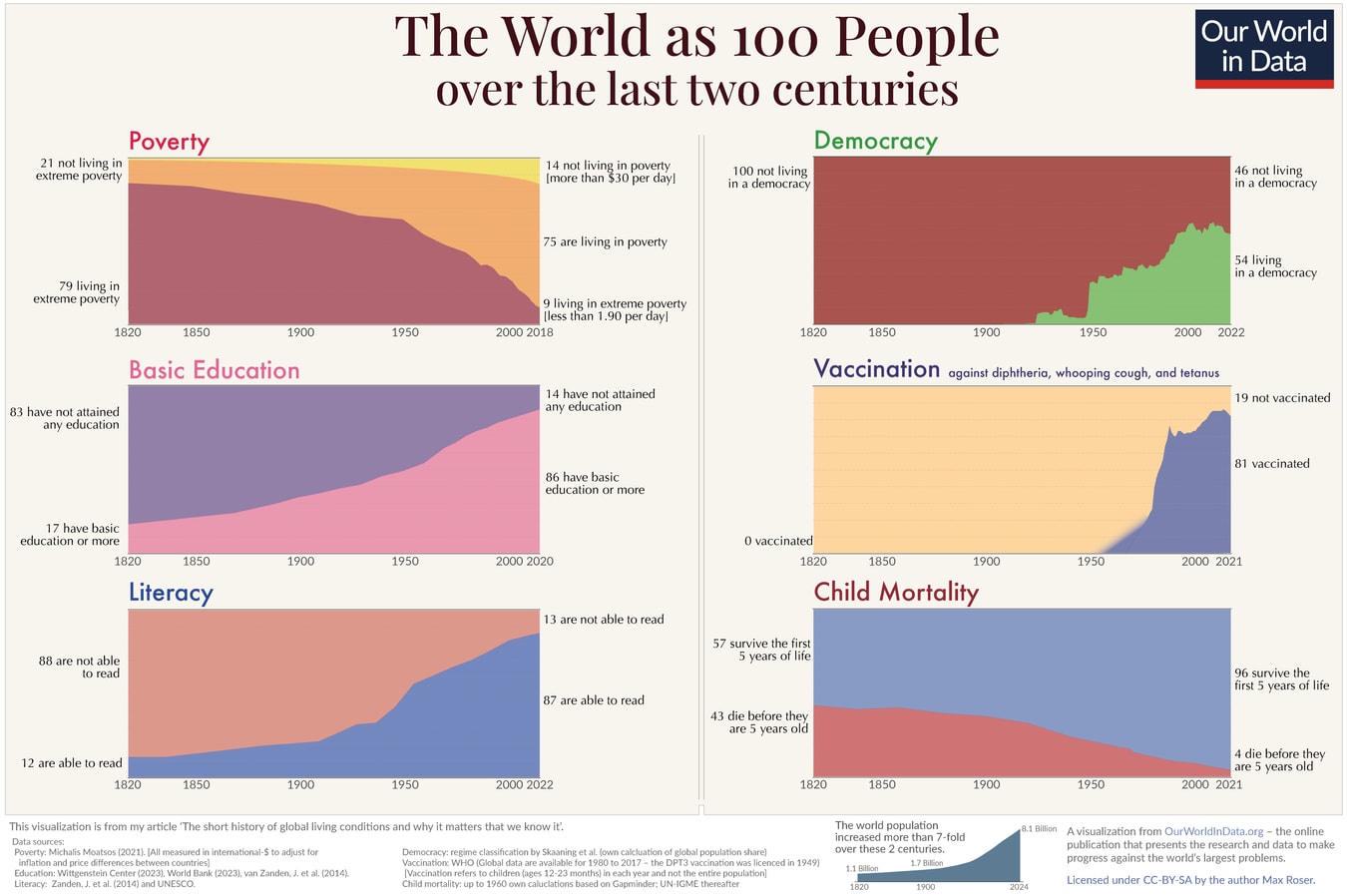
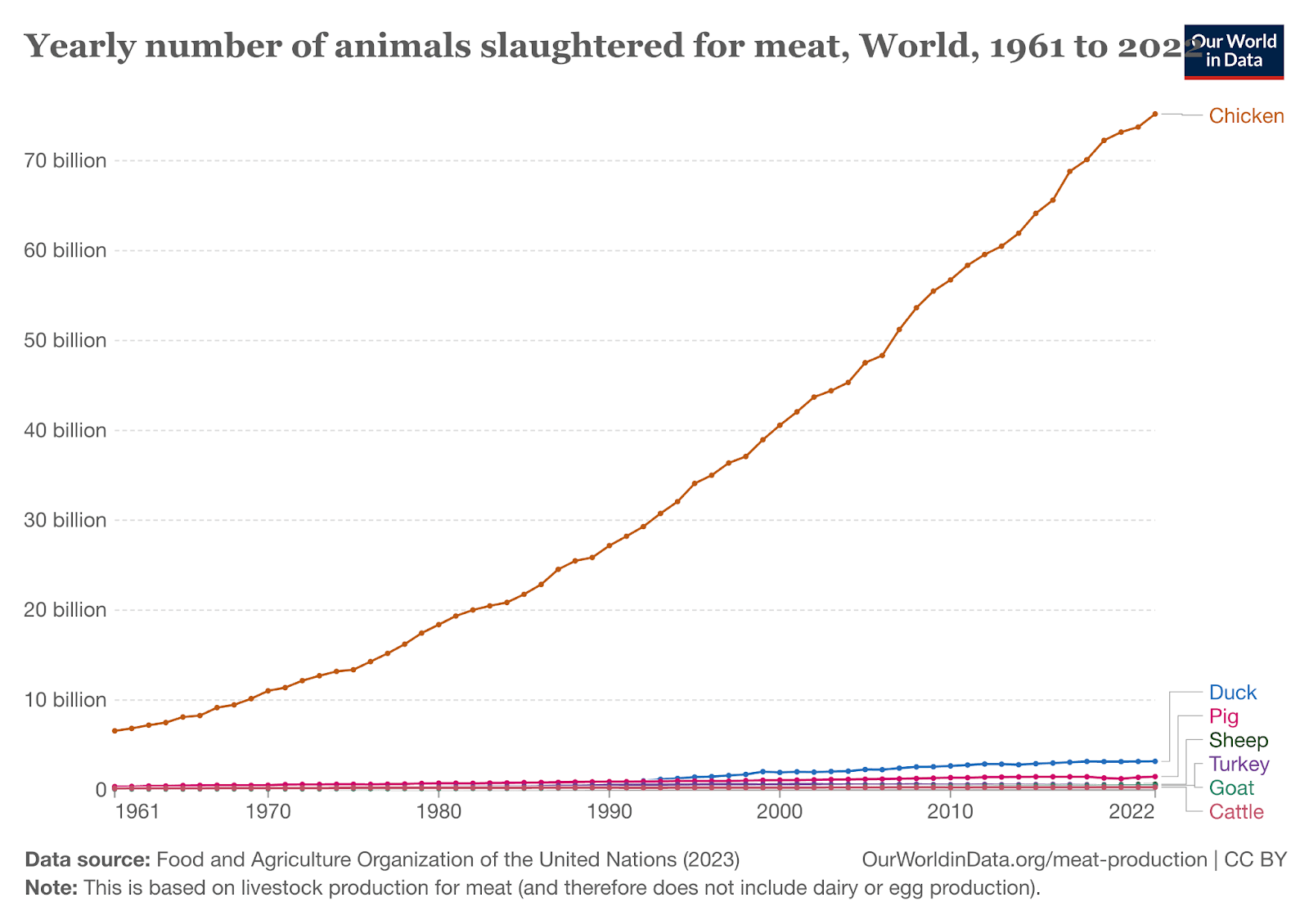
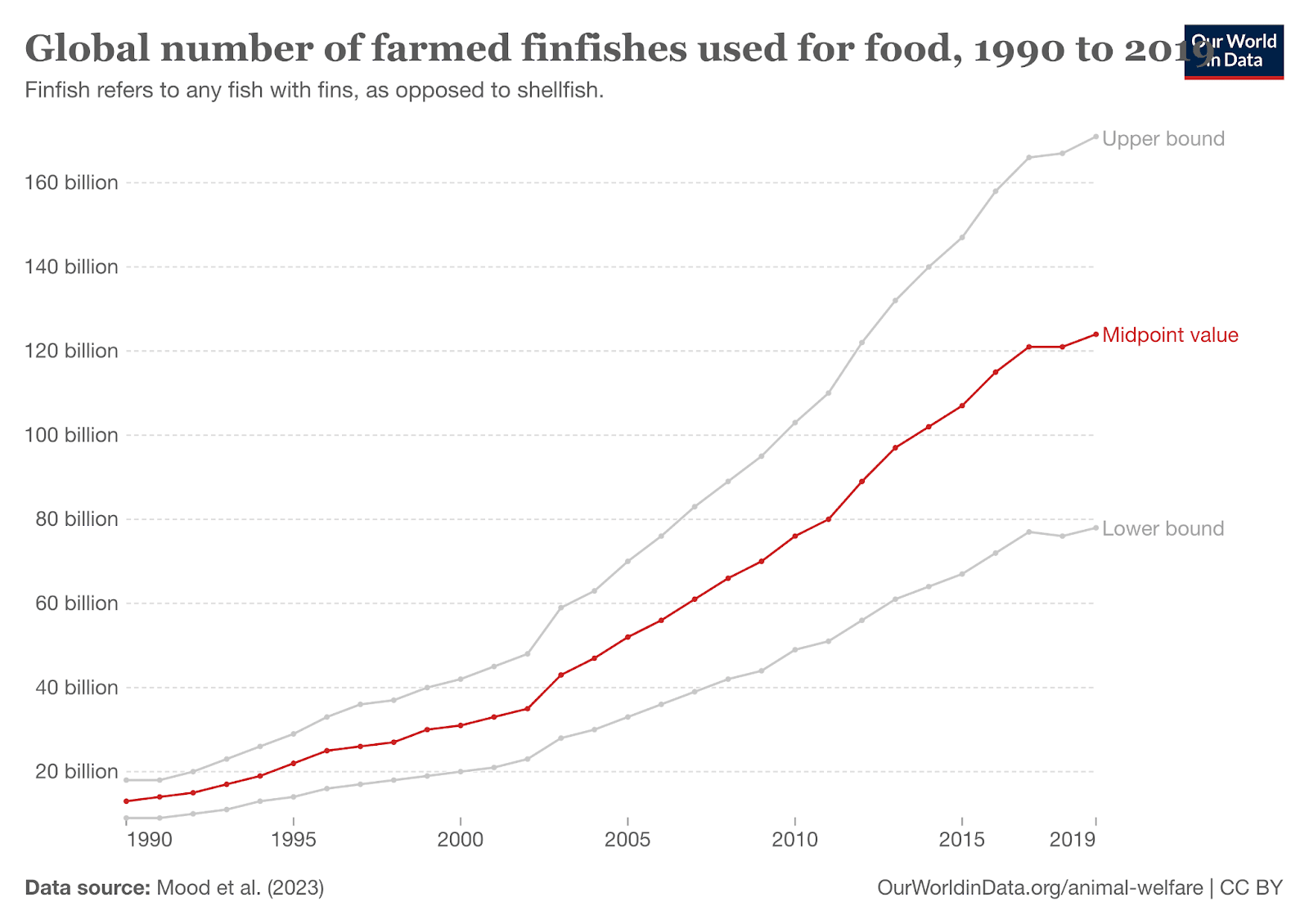
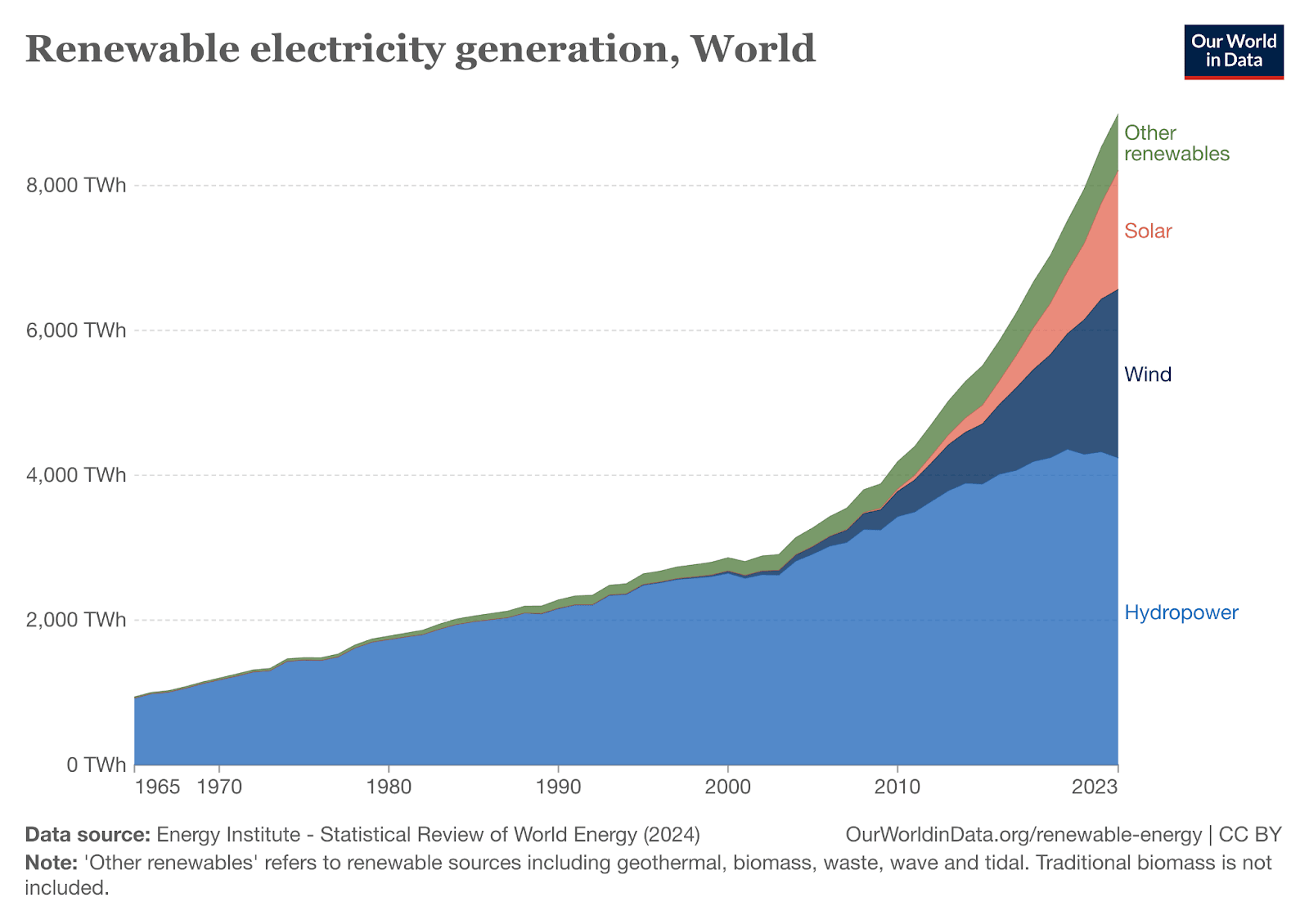
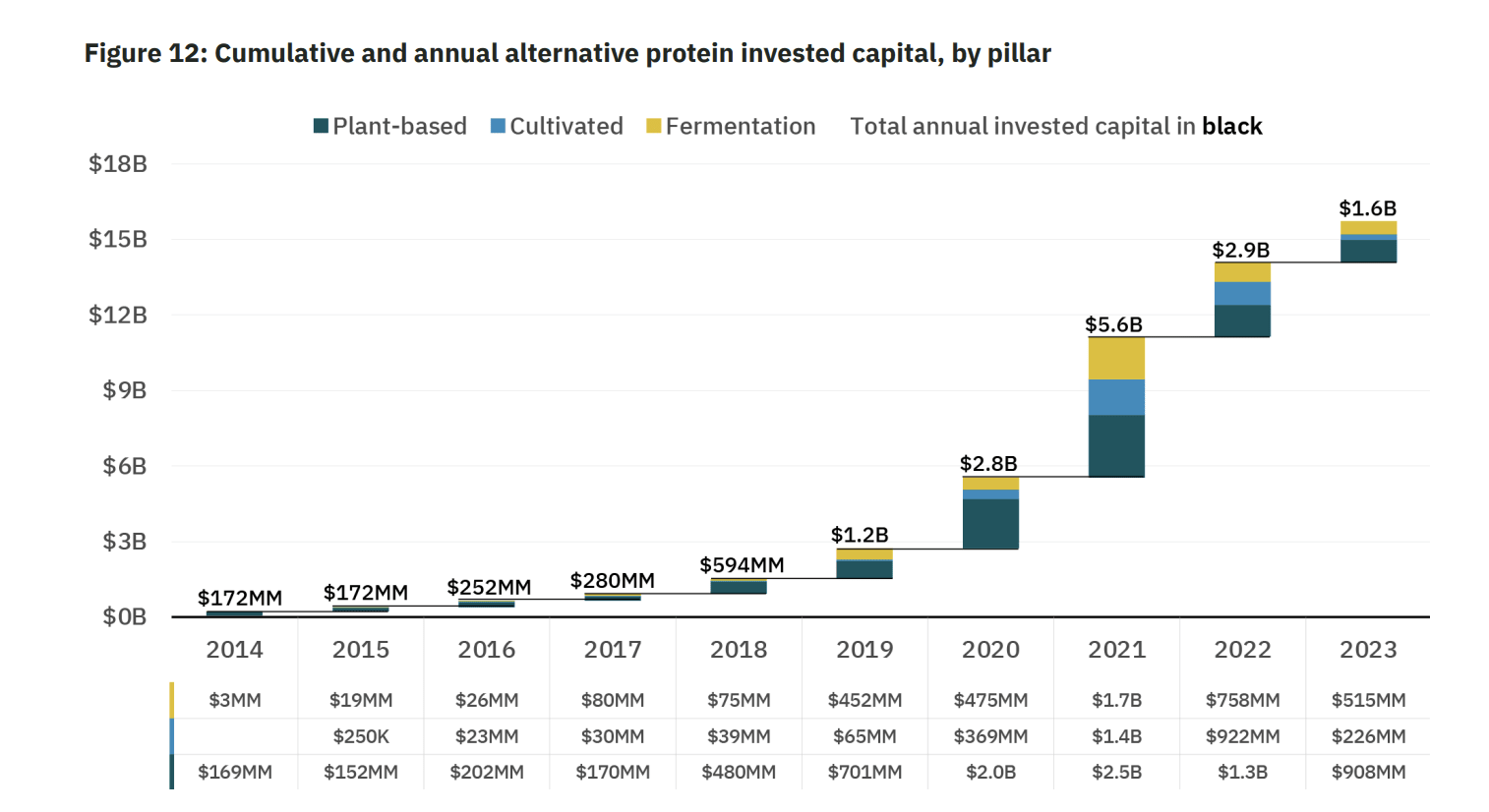
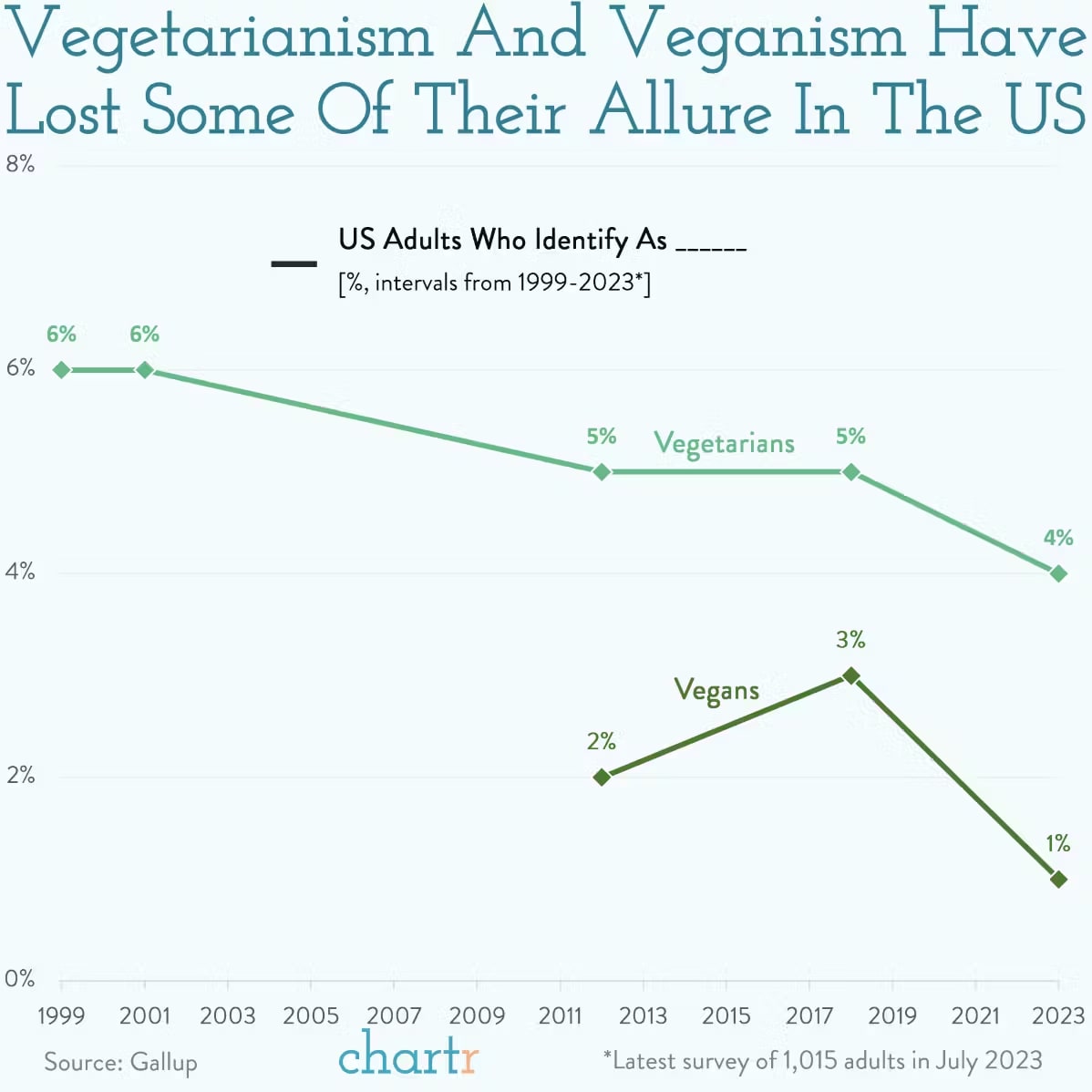

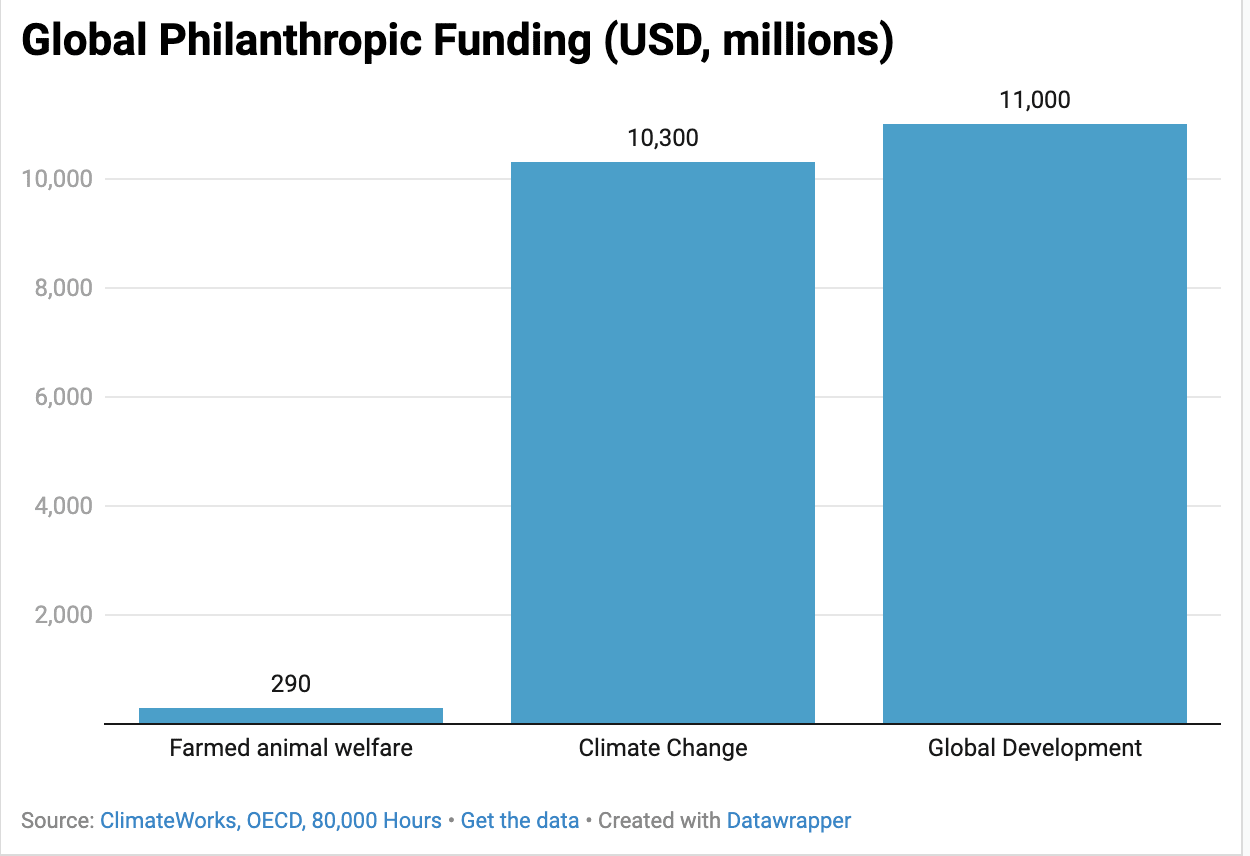
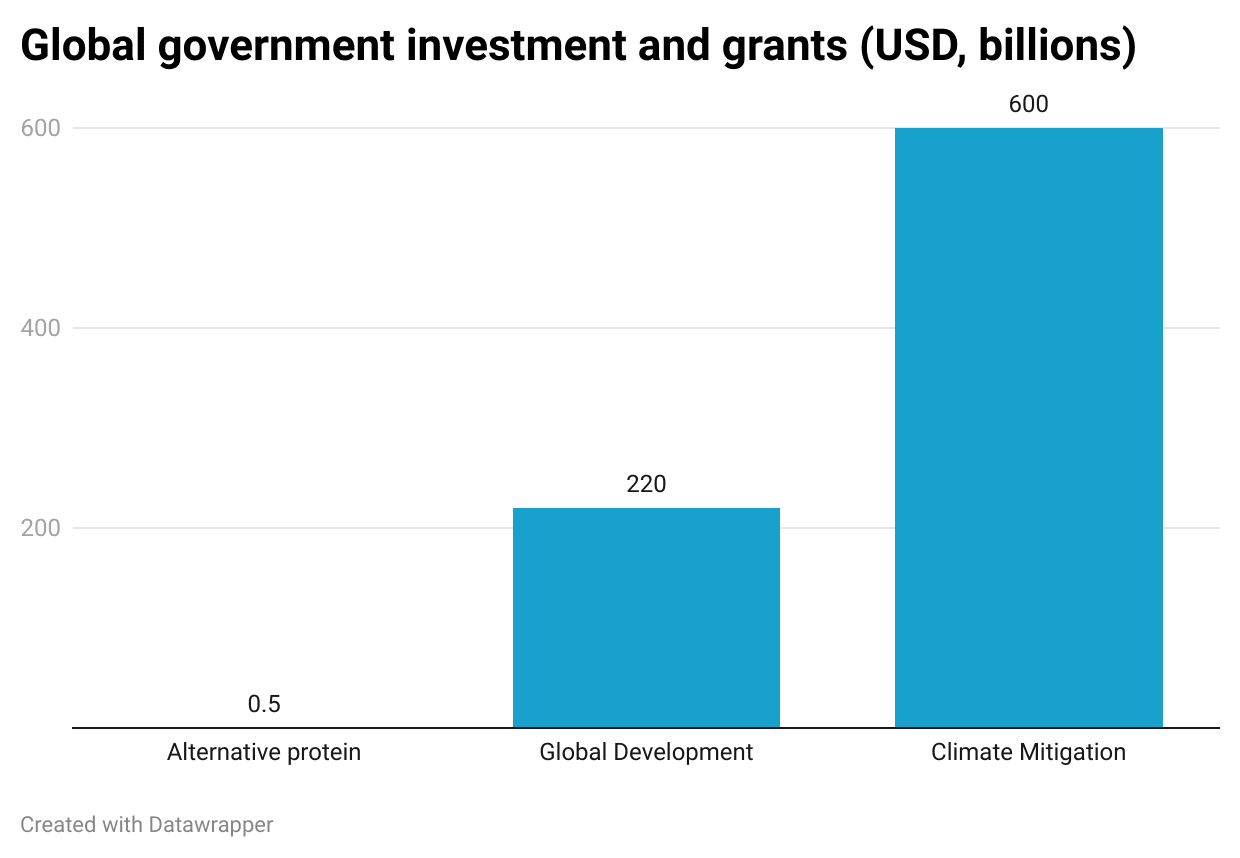
This is why I direct >90% of my giving to farm animal causes like THL, MFA, and the EA animal welfare fund.
Thanks for this excellent piece James. I had thought the trends were more positive than this, and am disheartened to hear that I was wrong.
One additional set of graphs I think would help set context is on the number of animals subject to some of the worst practices (e.g. battery hens). Many campaigns have been focused on avoiding some of the worst harms of factory farming, so presumably campaigners feel that reducing these practices is a big win. If so, we should be measuring it, celebrating the successes, and also putting them in context of the other big trends.
For longterm trend analysis, it would also be useful to have a geographic breakdown. e.g. if one of the main arguments for a good longterm outcome is a kind of ethical eating Kuznets curve — that as economic development increases, people first cause more harm to animals per capita, but then this decreases again. If so, we would expect to see this first in economically developed countries and measuring this would be helpful for understanding the timescale / income needed to bend that curve back down. And if there isn't any evidence of a Kuznets curve, that would be very important to know too!
Thanks for the kind words Toby! Yes, sadly the trends are not particularly positive at all.
There actually is some useful OWID data on hens and sadly it's not particularly positive on a global level (they estimate at least 3 billion in cages but I've heard this is likely an under-estimate and it's closer to 4-5 billion).
That said, there is certainly progress in the US and Western Europe, covered in this Vox article. The US cage-free percentage is around 42% now and I believe all cage-free progress across US and Europe equates to around 300 million hens out of cages relative to a couple of decades ago - a huge victory for animals and the animal advocacy movement as you note.
In terms of the Kuznets curve, that's definitely interesting and I agree it's worth considering if there is some element of progress in economically developed countries which will hopefully be matched as other countries develop. I think this is fairly clear for things like getting rid of some of the worst farming practices e.g. battery cages or gestation crates for pigs which has seen considerable success across the US and Europe. However, it's less clear on the meat consumption side of things as only Germany has seen a notable decline in meat consumption in the past 30 or 40 years (although we have seen a levelling off in the US and Europe which is some positive sign). That said, there is more chicken being eaten in most of these countries which likely means more animals farmed and killed overall. As such, I'm not convinced we have signs of a Kuznets curve for total animal suffering as it's quite likely the improvements we've made in outlawing some of the worst practices like battery cages are offset by increased chicken consumption.
Thanks for writing this up, James!
For those looking to start or increase their giving in animal welfare, here are two excellent EA-aligned resources to consider, presented in no particular order:
Animal Charity Evaluators
Animal Charity Evaluators (ACE) is a nonprofit organization that rigorously assesses and recommends the most effective animal welfare charities. By providing transparent evaluations and research, ACE helps donors make informed decisions to maximize their impact in reducing animal suffering.
EA Animal Welfare Fund
The EA Animal Welfare Fund is dedicated to supporting high-impact projects that improve the lives of animals, guided by the principles of Effective Altruism. By funding evidence-based initiatives, the fund ensures that contributions lead to meaningful and sustainable changes in animal welfare.
A few other re-granting programs you can contribute to include Thrive, ProVeg Grants, ReRoot Asia Fund, and Food System Research Fund, again, in no particular order.
If you're planning to make substantial donations, consider the two donor communities below. One requires individuals or foundations to contribute $100,000 or more annually to farmed animal advocacy, while the latter has a $250,000 yearly commitment. Both communities provide fantastic connections, guidance, and additional resources to support your giving.
Strategic Animal Funding Circle
Strategic Animal Funding Circle is a group of impact-focused donors who support promising animal-focused nonprofits with strategic funding. The animal-focused funding space is still small, and there are a lot of gaps to fill, starting from fueling talent to the movement, through mid-stage interventions, or best bets in the neglected regions.
Farmed Animal Funders
Farmed Animal Funders focuses on providing financial support to initiatives aimed at reducing the suffering of animals in factory farming systems. Through targeted grants and strategic investments, the organization empowers projects that promote better living conditions and advocate for the ethical treatment of farmed animals.
As James outlined, animal welfare receives orders of magnitude fewer resources, and the outlook for the billions of animals currently suffering—and those that will in the future—is generally bleak.
What a fantastic summary - love the visuals a lot. Sad and a bit shocked about the vegetarian/vegan trajectory there. What on earth is going on? is Gen Z letting us down?
Climate change funding also looking to skyrocket with countries pledging 100 billion a year, 10x what 80,000 hours estimated is currently going on here. I would have thought things like alternative proteins and pushing vegetarian diets could tap into some of that climate funding as I doubt there are many scenarios where international climate change goals can stomach a 40% increase in meat consumption by 2050.
Also I'm pretty sure there's waaaaaay more than 75,000 people working in the global development space, many of these will have far lower salaries than animal advocacy workers because they're working largely in low income countries.
I only read the title and bolded summary of this post but I upvoted it because
Is this post conditioning on AI hitting a wall ~tomorrow, for the next few decades? The analysis seems mostly reasonable, if so, but I think the interventions for ensuring that animal welfare is good after we hit transformative AI probably look very different from interventions in the pretty small slice of worlds where the world looks very boring in a few decades.
I probably agree with your sentiment and I get what you mean. If the world basically stood still though for the next 50 years I wouldn't find it boring, there's plenty enough going on to be interested in and get stuck into ;).
Quite like the Chesterton quote
"There is no such thing on earth as an uninteresting subject; the only thing that can exist is an uninterested person."
Not necessarily as severe as hitting a wall for the next few decades but in brief:
I think you misunderstood my framing; I should have been more clear.
We can bracket the case where we all die to misaligned AI, since that leads to all animals dying as well.
If we achieve transformative AI and then don't all die (because we solved alignment), then I don't think the world will continue to have an "agricultural industry" in any meaningful sense (or, really, any other traditional industry; strong nanotech seems like it ought to let you solve for nearly everything else). Even if the economics and sociology work out such that some people will want to continue farming real animals instead of enjoying the much cheaper cultured meat of vastly superior quality, there will be approximately nobody interested in ensuring those animals are suffering, and the cost for ensuring that they don't suffer will be trivial.
Of course, this assumes we solve alignment and also end up pointed in the right direction. For a variety of reasons it seems pretty unlikely to me that we manage to robustly solve alignment of superintelligent AIs while pointed in "wrong"[1] directions; that sort of philosophical unsophistication is why I'm pessimistic on our odds of success. But other people disagree, and if you think it's at all plausible that we achieve TAI in a way that locks in reflectively-unendorsed values which lead to huge quantities of animal suffering, that seems like it ought to dominate effectively all other considerations in terms of interventions w.r.t. future animal welfare.
Like those that lead to enormous quantities of trivially preventable animal suffering for basically dumb contingent reasons, i.e. "the people doing the pointing weren't really thinking about it at the time, and most people don't actually care about animal suffering at all in most possible reflective equilibria".
People could still pay for animal products from animals that are more traditionally/conventionally raised, without new technologies, for political, religious or other identity reasons. This could be most (social) conservatives. And AI could make the world's poor (social) conservatives much wealthier and able to afford far more animal products.
The cost to avert the suffering would be trivial, but so too would be the cost of conventional animal products, if and because everyone is rich. People could also refuse payment or other incentives to avoid conventional animal products.
And animals could continue to be bred for productivity at the cost of welfare, like has been done for broilers (although this trend for broilers is reversing in the West, because of animal advocacy from our extended community). Genetic engineering could also happen, but people averse to cultured and plant-based products might be averse to that, too, anyway. Some may be selectively averse, though.
I'd guess slaughter would be more humane, with better stunning, and maybe anaesthesia/painkillers would actually be used widely for painful mutilation procedures, and/or we'd just mutilate less. I'd guess people mostly wouldn't oppose those, although many Muslims do oppose stunning for slaughter for religious reasons.
And high welfare farming can be done in ways acceptable to conservatives, e.g. fairly natural, natural breeds, mostly outdoors, or with lots of space and enrichment. However, they may oppose transition towards that for political reasons. They tend to vote against farmed animal welfare reforms, probably not just for cost reasons, but also for political reasons.
Post-singularity worlds where people have the freedom to cause enormous animal suffering as a byproduct of legacy food production methods, despite having the option to not do so fully subsidized by third parties, seem like they probably overlap substantially with worlds where people have the freedom to spin up large quantities of digital entities capable of suffering and torture them forever. If you think such outcomes are likely, I claim that this is even more worthy of intervention. I personally don't expect to have either option in most post-singularity worlds where we're around, though I guess I would be slightly less surprised to have the option to torture animals than the option to torture ems (though I haven't thought about it too hard yet).
But, as I said above, if you think it's plausible that we'll have the option to continue torturing animals post-singularity, this seems like a much more important outcome to try to avert than anything happening today.
This is an aside, but I’d be very interested to hear you expand on your reasons, if you have time. (I’m currently on a journey of trying to better understand how alignment relates to philosophical competence; see thread here.)
(Possibly worth clarifying up front: by “alignment,” do you mean “intent alignment,” as defined by Christiano, or do you mean something broader?)
Great post, James!
I'm curious if you have any sense of how the average conditions/welfare levels of farmed animals are expected to change on this default trajectory, or how they've changed in the last few decades. I imagine this is difficult to quantify, but seems important.
In particular, assuming market pressures stay as they are, how should we expect technological improvements to affect farmed animal welfare?
My uneducated guess: optimizing hard for (meat production / cost) generally leads to lower animal welfare. This seems roughly true of technological improvements in the past. For example:
Hopefully we get a few more James Özden's too :)
“ because of how small we are” Pretty sure he’s already including himself in the list!
it’s crazy how many absolute pioneers are omitted here and the fact it’s hard for James to list them as someone hosting a podcast interviewing so many talented people and as a donor should be far more concerning to us.